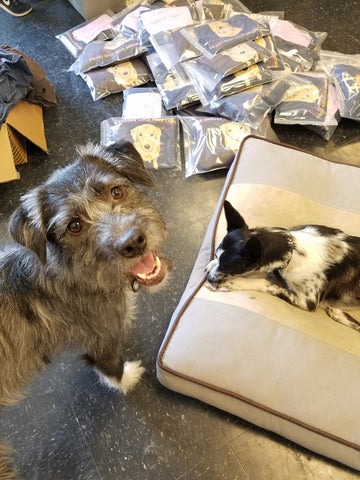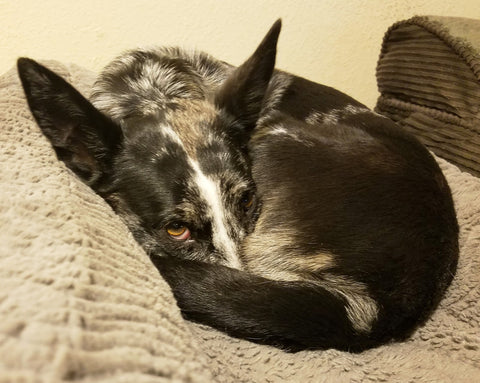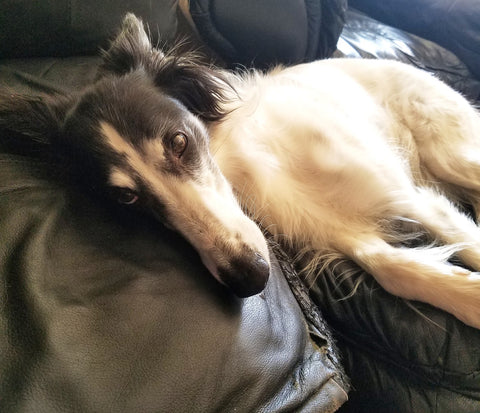My shopping cart
Call us at 888-424-4602 or email us at info@tuesdaysnaturaldogcompany.com for questions about your order status.
Your cart is currently empty.
Continue ShoppingBeing able to bring your dog to work is an amazing job perk! Having well-behaved dogs in the workspace helps reduce stress and provides many opportunities for positive interactions among employees and customers.
While some dogs can seamlessly be integrated in the work environment without much effort, other dogs may experience some stress at having to spend the day in a new place, surrounded by strangers. Here are some easy tips and suggestions for ensuring that your best friend has a good day while hanging out with you at work.

For higher energy dogs - wake up extra early so that you have time to exercise your dog prior to bringing them to work. For those really active dogs, a quick walk around the block won’t cut it. Take them on a jog, or throw a disc or ball for your dog.

Often times, dogs can be a little “amped” up after exercise - it’s easy to bring your dog to a calm state of mind by providing an activity that involves either thinking or chewing. Rather than feeding your dog’s breakfast at home, feed them while at work. Don’t put the food in a simple bowl! Bring a kibble dispensing toy to your office, so that your dog has to figure out how to push the toy around. Alternatively, you could stuff a kong with some canned dog food and freeze it overnight. A long lasting chew, such as a jumbo bully stick, or meaty raw bone, will also be greatly appreciated by your dog!
Please note: if your dog will be in close proximity to other dogs throughout the day, then we do not recommend having food/treats available in the common areas, as it may incite a fight.
Come to work 5 minutes early and hide some treats and kibble throughout your office. The act of “hunting”, or sniffing out hidden treats, is another activity that helps a dog achieve calm and focus. Some dogs are naturals at “hunting”, other dogs will require a few quick training sessions so that they can learn what the game is.
Provide a very comfortable dog bed and place it under your desk or in an area where your dog will feel secure. Dogs who feel safe at work will end up spending much of the day sleeping.
How do you pick a bed that your dog will absolutely love? Pay attention to their favorite sleeping position!

This Australian Koolie, named Circus, loves to sleep curled up. A bagel bed, like this bed from FYDO, would be a perfect fit for her!

This Silken Windhound loves to stretch out her legs and lay on her side while she sleeps. A large flat orthopedic bed, like the one that she’s laying on, is one of her favorite places to take a nap!

She also loves to drape her head over the arm of the sofa. If you notice your dog resting in this position, they would appreciate a bolster dog bed, like this one from Animals Matter!
(Want to read about all of the different sleeping positions of dogs? Click here to learn more!)
If you work at a location where there’s a lot of foot traffic (different dogs and people passing through), carry a treat bag, or keep a small bowl of treats at your desk, and offer your dog a treat even before they notice the other people/dogs going by. This will help desensitize your dog to the variety of visitors. You could also give them a treat every time you notice them calmly laying on their bed. By doing this, you’re communicating to your dog that it’s a good thing to be relaxing on their bed.
Build a routine for your dog. Take your dog on a 10 min walk after you finish eating lunch! If you have a regular routine that your dog can look forward to, it will help them be calm throughout the day - because they know just what to expect.

Bringing your dog to work at a busy pet store
When you work at a bustlin’ pet supply store, rather than a quiet office, it’s a whole different ball game! At a pet supply store, you have a constant barrage of different types of people and their own dogs walking through.
A good candidate for a “store dog” is an individual who is happy, stable, and social.
A nervy dog will be stressed out by working in a pet store environment for a prolonged time. If your dog constantly startles and barks at other people and dogs, they are not having a good time, and are disturbing your customer’s experience while they browse your store. By observing your dog’s body language, you can pick up on subtle signs that your dog is uncomfortable with the situation they’re in.
Signs of a stressed out dog:
If your dog regularly displays the above signs while at work, it may be kinder to leave them at home rather than forcing them to accompany you. A desensitization and counter-conditioning protocol, which would help teach your dog to not be stressed out, takes consistency and effort, which your employer may not appreciate you doing on the clock!
Etiquette with Store Dogs
Many customer-owned dogs (especially those on leash) who visit your store will not appreciate having an offleash dog rush up to them. Even if your store dog is friendly, it doesn’t mean that another dog wouldn’t find their behavior threatening. Train your dog to check in with you and “ask for permission”, rather than impulsively going up to any and every dog they feel like greeting. This article (click here) outlines the steps to train your dog to make eye contact with you as a default behavior. All you need are some delicious training treats, a treat pouch, and a clicker!
Don’t underestimate the importance of establishing a routine for your dog. Daily routines are very important to dogs, and they will often become upset if their routine is disrupted!
Do you bring your dog with you to work? E-mail us some photos of your dog at your workplace, we’d love to see them and share on our social media pages!